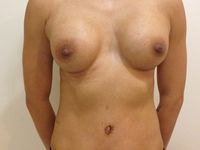The Procedure
These conditions may be due to skeletal abnormalities, e.g. pectus excavatum and pectus carinatum (pigeon chest), as well as muscular defects, e.g. Poland's syndrome. There may be more subtle forms of chest wall asymmetry caused by differences in breast volume and position e.g. Tuberous breast deformity, as well as asymmetry of the chest wall and ribs or thoracic skeleton such as scoliosis of the spine.
Reconstruction is tailored to the patient and the underlying condition and surgical options may include refashioning of the skeleton, muscle flap cover, or the use of prosthetic material to camouflage the defects.
Breast Asymmetry
In female patients, it is possible to camouflage small to moderate asymmetries of the chest region with the use of breast implants placed over the pectoralis major muscle.
The new cohesive silicone anatomical (or teardrop) implants have enough versatility in their range of shapes and sizes to taylor each side to achieve near perfect symmetry. It is possible to use an identical height and width for the two sides, but use a different projection or profile to correct differences in chest wall and / or breast projection.
Dr Belt uses a specialised 3- Dimensional photographic simulation (Vectra TM) to accurately assess the breast volume of each side. This specialised equipment also permits simulation to show how the results would look after the procedure. Dr Belt also uses trial sizers and implants at the time of the consultation to assess the difference between the two sides and show how the various implants would achieve the desired results.
It is also possible for exact sterile sizes to be used at the time of the surgery to further refine the choices of implant size and dimensions. The implant companies supply these sizers at no additional cost to the patient. Doctor Belt would be happy to see you and advise how these techniques can be tailored to your specific condition.
Chest Wall Correction
Please note Dr. Belt does no longer performs chest wall correction on male patients. Please contact your GP for a referral to a cardiothoracic surgeon if you are a male patient seeking this surgery.
Please contact Dr. Belt’s team for more detailed information and advice about your specific condition. Dr Belt is happy to conduct a telephone consultation with you prior to your appointment.
Poland's Syndrome
Poland’s syndrome is thought to be due to a kinking of the subclavian artery (the main artery to the arm and chest) at the sixth week in gestation. This causes abnormalities to the upper limb and chest. The features can range from mild to severe deformities.
The chest wall problems include abnormalities to the muscles of the chest wall (pectoralis major and minor, serratus anterior, latissimus dorsi and rectus abdominis), underdevelopment of the breast and nipple areolar complex and lack of axillary hair.
The upper limb problems can include a shortened arm and fingers and fused central fingers (symbrachydactyly).
Techniques to reconstruct the chest wall include :
- Reconstruction of the underlying chest wall deformity
- Reconstruction of the breast mound with a tissue expander which can be inflated to keep up with the growth of the opposite breast, and then replaced with a definitive implant
- Flap reconstruction using a pedicled latissimus dorsi flap or a free flap reconstruction (e.g. a TRAM flap).
Tuberous Breasts
The condition of tuberous breast deformity can cause abnormalities of breast volume, volume distribution, breast shape, and nipple areolar size and shape. The lower pole of the breast is the most commonly affected. There may be associated protrusion or herniation of the breast tissue into the areola. This can result in an enlarged areola and a constricted base to the breast. There may occasionally be a shortage of breast skin and the crease underneath the breast may be abnormally high. There is usually breast asymmetry with differing degrees of abnormality in each breast.
There are a number of degrees of severity depending on the constriction of the breast base, the level of the breast crease, the skin envelope, the breast volume and the nipple areolar complex. The severity will influence the type of treatment employed.
The principles of treatment are to expand the constricted base, lower the breast crease, increase the skin envelope, augment the volume, reduce the nipple areolar complex and the herniated breast tissue and restore symmetry to the breast.
The treatment options include :
- Breast uplift of mastopexy
- Breast augmentation
- Tissue expansion
- Combinations of the above
Dr Belt will assess your specific requirements and will taylor your operation(s) to your specific clinical requirements.

Complications and Risks
All Procedures have potential complications and risks. These can be divided into general complications and those specific to each procedure. The latter are listed in the FAQs below.
General complications include:
- Wound complications - bleeding, bruising, collections under the skin of blood (haematoma), pus (abscess), serous fluid (seroma), infection, wound breakdown, suture extrusion, sensory loss;
- Aesthetic complications - poor scars, stretched scars, raised scars (keloid or hypertrophic), contour irregularities, need for revisional procedure;
- Anaesthetic complications














